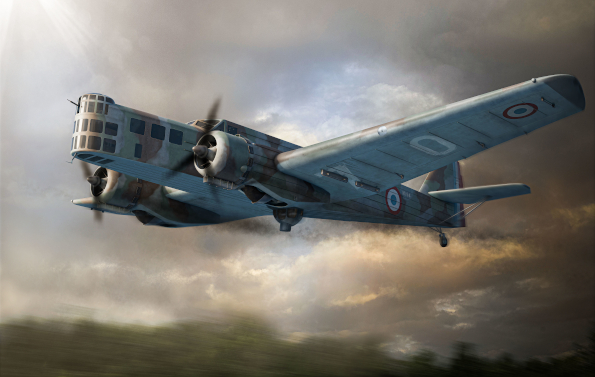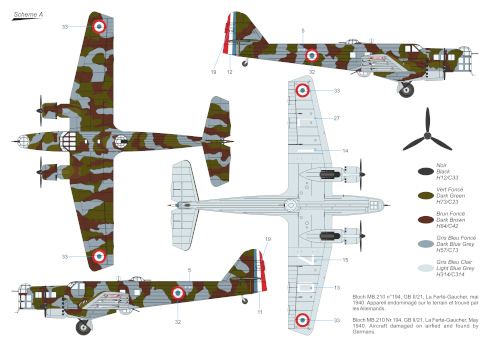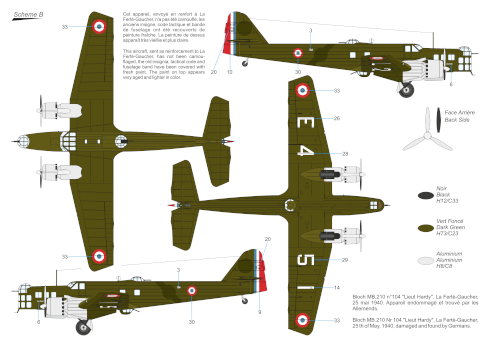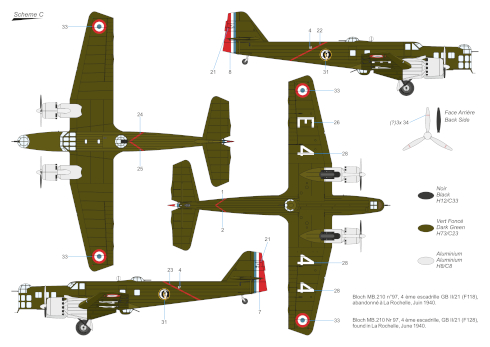FR0056 Bloch MB 210 at war
History:The Bloch 210 was initially developed as a floatplane with two Gnome & Rhône radial engines in response to an Aéronautique Navale requirement. Construction of the prototype began in 1933 and first flew on November 23, 1934. Fitting retractable landing gear and a few other modifications resulted in the 4-man night bomber version for the Armee De l'Air. This was designated BN4 and powered by 900 ch Gnome & Rhône 14 Kirs/jrs engines.
In 1934 and 1935, two orders were placed for 130 units. The first production aircraft’s maiden flight was on December 12, 1935. The second and all subsequent aircraft had increased wing dihedral, whilst the third onwards had a shorter vertical tail. A total of 257 MB 210s were produced for the Armée de l'Air. Ten aircraft were exported to Romania in 1937, while others were sent to Republican Spain.

The first French aircraft were assigned to GB I/12 and II/12 at Reims, and II/19 and II/21 at Bordeaux. However, a series of accidents prompted the General Staff to ground the MB 210s between September 1937 and March 1938. The main reasons for these accidents were insufficient power from the G&R 14 K engines, and pilot unfamiliarity with the aircraft’s technical innovations like retractable landing gear and variable-pitch propellers. Improved training and the replacement of engines by slightly more powerful G&R 14 Ns (910 ch at take-off) enabled bomber groups to resume conversion to the MB 210.
The MB 210 was the most widespread bomber in the Armee de l'Air at the outbreak of war, with 180 aircraft divided into 12 Groupes de Bombardement, as follows:
- GB I/11, based in peacetime at Toulouse-Francazal, moved to Vergières (Istres) at the end of August, then to Mas de Rus (Arles) in December 1939. LeO 451s replaced its MB 210s from March 1940 on.
- GB II/11, also based at Toulouse-Francazal before the war, moved to Istres, where it was partially transferred to LeO 45s from December 1939. As LeO crews were not trained for night flying, MB 210s carried out the night bombing of Northern Italy on June 13, 15 and 17, 1940.
- GB I/12, usually based in Reims, moved to Auzainvilliers (Vosges) when war was declared, then to Caen on September 8, where it began its conversion to the LeO 45 which was completed in October.
- GB II/12, based at Reims-Courcy in peacetime, moved successively to Damblain, then Caen and finally Orange, where it was completely converted to the LeO 45 at the end of the year.
- GB I/19 was at Sétif (Algeria), where it was converted to the DB-7 from April 1940, returning to mainland France where it took part in the fighting, but on the DB-7.
- GB I/21 from Bordeaux moved to Chambry (Aisne), then to La-Ferté-Gaucher (Seine-et-Marne), and finally to Avignon-Châteaublanc in January 1940, where an experimental squadron on Amiot 354s was set up. The group was transferred to Connantre (Marne) on May 18. It flew many night missions with MB 210s and sometimes Amiot aircraft, until its withdrawal to North Africa on June 19.
- GB II/21 was based at Bordeaux Mérignac, and moved to Athies-sous-Laon (Aisne) at the end of August 1939, then to Nangis on September 18. It was transferred to Avignon-Châteaublanc on December 21, and took delivery of some Amiot 354s. On May 16, 1940, the unit, equipped with two Amiots and 10 MB 210s, set off on night missions, based successively at La-Ferté-Gaucher, Nangis, St Florentin and Avord. From June 15, the Group moved to North Africa.
- GB I/23 moved from Toulouse-Francazal to Istres in September 1939 and began re-equipping with LeO 45s in February 1940. The Group didn't seem to be a priority, and its allocated LeO 45s were taken away for use by other Groups. The situation worsened when the Group went to the front on May 23 and was allocated worn-out MB 210s from other units. GB I/23 operated out of Pont-Sur-Yonne and Chaumont-Semoutiers. The poor state of its equipment led to aircraft and personnel losses through accidents, and eventually the Group was banned from operating MB 210s.
- Between April and August 1938, the GB II/23 switched from the MB 200 to the MB 210 at its Toulouse-Francazal base. It was transferred to Istres when war was declared, then to Vallon from December 8. A few LeO 45s were delivered in February 1940, and the Group was moved to Orange-Plan de Dieu on May 27, and to the Étampes region on June 2. From June 6, the Group ceased using its MB 210s for operations and switched to LeOs.
- GB I/51, normally based at Tours, was transferred to La Perthe airfield (Aube) on August 27 and carried out its first wartime mission on September 9, 1939. Twenty-three night reconnaissance missions were conducted between September 16 and November 22. On December 4, the unit left for Le Luc airfield, where it was converted to Breguet 691 ground-attack aircraft.
- GB II/51, also at Tours, was converted to MB 210s in January 1938. It was transferred to Troyes, where it carried out 20 reconnaissance and leaflet-dropping missions between September 2 and December 6, 1939, before being sent to Le Luc, where it was converted to a Breguet 690 ground-attack unit.
he General Staff was well aware that the aircraft was outdated and undertook the conversion of the groups still equipped with MB 210s to more modern types (LeO 450, Amiot 350, DB-7). However, insufficient production by the French aircraft industry meant this program could not be completed successfully.
By the end of the French Campaign, around a hundred MB 210s remained in mainland France, and around twenty at Algiers Maison-Blanche. In July 1940, the MB 210 was withdrawn from the front line. However, during the invasion of the Free Zone, the Germans recovered 37 MB 210s, which were used in schools or as transport aircraft.
The ten Romanian aircraft were delivered in 1937, in two batches. They were painted overall green like the French MB 210s of the period but with Romanian roundels and fin flash, and their engines had annular exhausts. Shortly before Germany attacked the USSR on June 22, 1941, an attack in which the Romanians joined, at least one aircraft was camouflaged with its roundels replaced by Michael 's Crosses. The MB 210s were grouped in 82 Squadron, which operated mainly over Bessarabia from its base at Erculesti, south of Focsani, the first mission occurring on July 8, 1941. The MB 210s took part in the attack on Odessa in August but were withdrawn from the front line at the end of the month. Aircraft No.5 and No.6 were used as transport aircraft by the Flotila 2 Bombardament, while the other surviving MB 210s were transferred to the Flotila 3 Aerotransport.
A few aircraft were sent from France to Republican Spain at the start of the Civil War. The first production MB 210 was delivered by Lionel de Marmier to Barcelona at the end of August 1936, after which it was grounded in Albacete for two months. Three further MB 210s built by Hanriot were delivered in crates at the end of October 1936. One was briefly part of the Escadrille Malraux, and then several MB 210s were assigned to the short-lived "Escadrille Bloch", after which two were transferred on March 1, 1937 to the Lerida-based Grupo 11, a bomber unit. An MB 210 marked with a large white M on the tail belonged to the 2nd squadron of Grupo 12, and carried out night bombing runs until June 1938. Two MB 210s were assigned to the Totana multi-engine school.
Specifications: twin-engine night bomber with four (Bn4) or five (Bn5) crew members, Gnome & Rhône GR 14 N10/11 14-cylinder radial engines, 910 ch at take-off and 950 at 3,500 m. Speed 320 km/h at 3,500 m, ceiling 9,900 m, wingspan 22.81 m, length 18.9 m. Offensive armament: 1,600 kg of bombs, defensive armament: a MAC 34 7.5 mm machine gun in each turret.The kit will contain two types of engines (one with a ring collectir, one with direct exhausts) and two types of fin / rudder
FR0056 Bloch MB 210 at war (release : early january 2025 - needs a new, more rounded, rudder tip):
- Nr 194, GB II/21, La Ferté-Gaucher, May 1940. Aircraft damaged on airfied and found by Germans
- Nr 104 "Lieut Hardy", La Ferté-Gaucher, 25 th of May, 1940, damaged and found by Germans. This aircraft, sent as reinforcement to La Ferté-Gaucher, has not been camouflaged, the old insignia, tactical code and fuselage band have been covered with fresh paint. The paint on top appears very aged and lighter in color.
- Nr 97, 4 ème escadrille, GB II/21 (F128), found in La Rochelle, June 1940.


